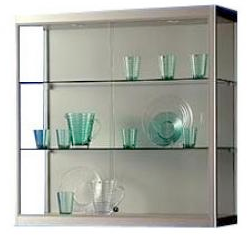
Would you talk more about collections and clutter? Ways to display collections, perhaps? We are overrun with a collection. Like yours, it's mixed media.
Let's start with some general principles, and then move on to display ideas. The principles are just guidelines; there will always be situations where they don't apply.
Principle 1: Only keep what you love.
Cull the collection periodically; remove the items that are second (or third, or fourth) best. Perhaps someone gave a gift that just isn't quite right for you. Perhaps your tastes have changed. Perhaps you're a more discerning collector than when you started. Try to have a collection where everything is a favorite.
Principle 2: Consider limiting the space you allocate to the collection.
This is a general organizing principle; it doesn't apply just to collections. For example, I have only so much bookshelf space in my home - a fair amount, for sure, but still limited. If the books don't fit, something has to go. The same idea can be applied to anything you own, including a collection.
Principle 3: Consider a rotating display.
You don't have to display everything in your collection at once. You can put out as many items as you have room to display well - and then change that display on a regular basis.
Principle 4: However you display your collection, be sure to consider safety.
If you have small children, don't keep small items on display where they may find their way into the child's mouth. If you live in earthquake territory, consider this when determining how to handle the display. And as Barbara Jennings points out, "Any part of your collectibles that have real value should be displayed behind glass doors for protection. This discourages well-meaning but clumsy friends from touching them and keeps children away from them too. It will also cut down on dust and dirt from causing any damage."
OK, on to the display ideas. Some of these go beyond "organizing" into the realm of interior decoration, and I'm not an interior decorator - so you may want to consult someone who is! (If any readers are decorators, please chime in with a comment!) But I've read the advice of people who are designers, and that's informed the points which follow.

1. Group the items.
A collection of glass bottles or figurines or decorative plates, displayed together, has much more impact than one displayed on its own. Lainey Powell (Lainey's Repertoire) demonstrates this nicely with the collection of shells. One shell? Not very compelling. A grouping of shells? Lovely.
(And feng shui speaks about the importance of pairs of things, rather than single objects.)
2. But don't group too many!
Here's a guideline from Barbara Jennings: "Avoid displaying more than seven items in any one place at one time. It is just too cumbersome for the eye to take in more than that and you defeat your purpose that way."
Now obviously, sometimes the whole idea is the pure massiveness of the collection - see the Pez display above. And certainly the number seven isn't sacred. But anyone who has seen overcrowded displays where your eye can't ever seem to rest anywhere will relate to this advice.
Laurie Ward writes about the hazards of trying to display too much - "dozens of tiny figurines on a small side table, for example" - which "will only distract from the individual pieces."

3. Layer the display.
This is one place where I will definitely send you to interior decorators for specific suggestions. One is Carole Talbott, who speaks of "building peaks and valleys," and the need to keep "large with large, small with small." This collection of old ornaments, displayed in covered dishes of varying heights, seems to be a nice example; the photo comes from J.E. Fee (Weaselmcfee).

4. Place some in unexpected places.
Erika Ecker has this great example: "Have a collection of small molded plastic figures? If they are out of their original packaging, tuck them in random places around the house. What a surprise to open the freezer and see Spiderman in there guarding the frozen blueberries. Reach for a drinking glass and find Mr. Incredible. Grab a q-tip out of your medicine cabinet and be greeted by Godzilla."
I have a few stuffed animals, and the photo above shows you where one of them resides. It gives me a smile every time I go to the pantry (a converted linen closet).

5. Use specialized display cases and other products.
See if someone makes display cases designed for your type of collectible.

Curio cabinets come in all sorts of styles and sizes.

Curio or display tables are another option.

And there are all sorts of wall showcases, too.

6. Consider products meant for retail stores.
There's no reason you can't use these in the home! The item above is one example - a point of sale display.

7. Use the walls.
That's what Abbey Hendrickson (hownowdesign) did! [via The Kitchn]
8. Get inspiration from the pros: museums, stores which do great displays, etc.
For more inspiration, see these photos of:
- Vintage baseball catchers masks. (scroll down)
- Clip On Ties.
- Christmas ornaments in apothecary jars.
[Pez collection from One Good Bumblebee / Katey, via Apartment Therapy]

2 comments:
This is fantastic! I've been meaning to start up a discussion on this, but you've covered all the bases. I definitely share the opinion that there's room for collections (and having them out to enjoy) even in a minimalist home. Stumbled!
Thank you, Sara!
Post a Comment